|
|
|
Sort Order |
|
|
|
Items / Page
|
|
|
|
|
|
|
| Srl | Item |
| 1 |
ID:
180015


|
|
|
|
|
| Summary/Abstract |
This paper investigates the usage and frequency of what is referred to as K-suffixes in three Balochi dialects, namely Koroshi, Coastal and Sistani Balochi. It shows that K-suffixes are most likely the reflexes of earlier evaluative morphology, traditionally termed “diminutives,” and are characterized by a high degree of multi-functionality. While in Coastal and Sistani Balochi evaluative functions continue to dominate, they have been largely lost in Koroshi Balochi, and the suffix is now used to indicate definiteness. The development appears to have been spearheaded by female speakers, and its frequency is also dependent on genre and speech situation. Data is taken from an extensive corpus of spoken Balochi narratives and from a questionnaire with thirty-six speakers. The results suggest that evaluative morphology can develop into definiteness marking, with the development passing over a stage of combination with deictic markers. The paper concludes that the development of definiteness marking can proceed down a pathway that is distinct from the one normally assumed for demonstrative-based definite marking, though the endpoint may be similar. This is the first detailed documentation of this process for any Iranian language, and one of the few well-documented cases of a non-demonstrative origin of definiteness marking worldwide.
|
|
|
|
|
|
|
|
|
|
|
|
|
|
|
|
| 2 |
ID:
180018


|
|
|
|
|
| Summary/Abstract |
Farvi, also known as Farrokhi, is an Iranian language spoken in the village of Farvi in Khur district of Kavir desert in central Iran. It shares features with other languages in Kavir region such as Khuri, Irāji and Garmayi. This paper describes synchronic and historical phonology and the grammar of Farvi based on data collected in Farvi village during April 2019. The study of historical phonology and morphological evidence show that though basically Northwestern, Farvi shares some features with Southwestern Iranian languages so that, like Kurdish and Balochi, it is separated from the other Northwestern Iranian languages. In later changes, Farvi shows some areal features that put it alongside Southeastern languages such as Northern Bashgardi and Balochi.
|
|
|
|
|
|
|
|
|
|
|
|
|
|
|
|
| 3 |
ID:
180024
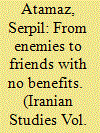

|
|
|
|
|
| Summary/Abstract |
This paper examines the historical developments and the debates revolving around the formation of an Ottoman–Iranian alliance in the Ottoman Empire in the aftermath of the 1908 Revolution. It argues that although neither the idea of an alliance between the two states nor the attempt to establish it was new, the way it was discussed, justified, and promoted in this period was different. The previous attempts by the Ottomans were led by the state as part of a broader pan-Islamist project (ittihad-ı İslam) that adopted a heavily religious tone. On the other hand, the main proponents of the alliance during the constitutional period were mostly transnational/international figures and religious scholars, who framed the issue within the context of Ottoman–Iranian relations, focusing on immediate pragmatic, strategic, and ideological concerns, such as protecting the sovereignty and security of the two countries against European imperialism through constitutionalism. Rather than focusing on reconciling the disputes between the Sunnis and Shi’is, and presenting this alliance as the first step towards the formation of a broader Islamic union as Abdülhamid II did in the nineteenth century, these people emphasized brotherhood and solidarity between the two constitutional governments, and tried to establish a strategic partnership based on shared borders, experiences, ideals, and enemies.
|
|
|
|
|
|
|
|
|
|
|
|
|
|
|
|
| 4 |
ID:
180032
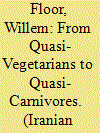

|
|
|
|
|
| Summary/Abstract |
Until the twentieth century there was little change in the diet of Iranians. Bread was the major staple, accompanied by vegetables, fruits, yoghurt, and nuts. Meat and rice were a luxury food for most consumers. In the nineteenth and twentieth centuries new food items were adopted by Persian consumers. After 1970, the modern Iranian diet—large amounts of white rice, meats, sugar-sweetened beverages and sweet/deserts, with few vegetables, herbs, nuts or fruits—has grown increasingly similar to the US diet, with the same health problems.
|
|
|
|
|
|
|
|
|
|
|
|
|
|
|
|
| 5 |
ID:
180034
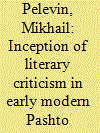

|
|
|
|
|
| Summary/Abstract |
The article overviews the earliest Pashto texts, mostly poetic, in which the incipient forms of literary criticism can be traced as authorial self-reflections related in Persian classics to the self-praise genre (fakhriyya) and explanations of reasons for composing works (sabab-i taʾlīf). Under close examination are the seventeenth century verses of the poets affiliated with the Roshānī religious community and the writings of Khushḥāl Khān Khaṫak (d. 1689). Analyzed texts prove that through the rudimentary discourse on a variety of literary criticism topics, Pashtun authors of early modern times declared and justified the presence of emerging literature in Pashto within the Persophone cultural space of Mughal India, articulating simultaneously their commitment to the proliferation of literacy and Islamic book culture among their countrymen.
|
|
|
|
|
|
|
|
|
|
|
|
|
|
|
|
| 6 |
ID:
180029
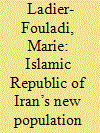

|
|
|
|
|
| Summary/Abstract |
After dropping rapidly and steadily over two decades, fertility in Iran stabilized between 2001 and 2011 at around 1.9 to 2 children per woman, before starting to rise slightly between 2012 and 2016, then falling fairly quickly. This coincided with the implementation of the Islamic Republic’s new population policy, with its aggressive and coercive measures, one of whose goals was to reverse the downwards trend in fertility. Given changes in proximate and remote determinants of fertility in Iran, and the decline in fertility since 2016, it is assumed that this new population policy triggered a reduction in intervals between births between 2012 and 2015, leading to a slight rise in the fertility of already married couples. The other latent objective of the Islamic Republic’s new population policy is to drive Iran’s population up to 150 million inhabitants in the near future. This is utopian given Iran’s demographic dynamics, but it conceals the political and ideological goal of asserting Iran’s demographic and geopolitical significance within the region, by drawing on a novel immigration policy to make up for its low fertility.
|
|
|
|
|
|
|
|
|
|
|
|
|
|
|
|
| 7 |
ID:
180017
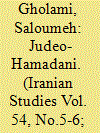

|
|
|
|
|
| Summary/Abstract |
The study of the language of religious minorities in Iran is particularly important for understanding the historical development and typology of Iranian languages. Historical and linguistic evidence substantiates the idea that Zoroastrians and Jews in cities in central and western Iran preserved their former vernacular language, whereas the majority of the population replaced it with Persian in the New Iranian period. This paper focuses on the language of Jews in Hamadan and has two main objectives: first, it examines numerous distinctive features of Judeo-Hamadani; second, it reviews and updates recent research to clarify the language origins, using data from new materials recorded during fieldwork in Hamadan from October 2018 to August 2019, and in Yazd in 2017.
|
|
|
|
|
|
|
|
|
|
|
|
|
|
|
|
| 8 |
ID:
180016
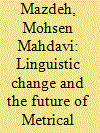

|
|
|
|
|
| Summary/Abstract |
The metrical requirements of Persian poetry are highly restrictive. Traditionally, the rigidity of the metrical system was compensated for by a high degree of flexibility in the poetic language in terms of lexicon, phonology, and morpho-syntax. Using statistical data from different periods of Persian poetry, this paper argues that the degree of flexibility of the language used in metrical Persian poetry has been in constant decrease, moving towards what may potentially be a language crisis for metrical Persian poetry. This study traces the linguistic and meta-linguistic origins of the initial flexibility of the poetic language and its subsequent change, suggesting that some of the recent trends in Persian poetry may be viewed in part as reactions to this potential crisis.
|
|
|
|
|
|
|
|
|
|
|
|
|
|
|
|
| 9 |
ID:
180019
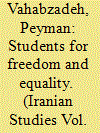

|
|
|
|
|
| Summary/Abstract |
The emergence and rapid but short-lived presence of Students for Freedom and Equality (SFE; in Persian: Daneshjuyan-e Azadikhah va Barabaritalab or DAB) across major Iranian campuses and their fateful 4 December 2007 protest rally on the campus of the University of Tehran speaks of the return of leftist student activism to Iranian campuses after almost two decades of absence or invisibility within the context of post-revolutionary Iran. SFE was an umbrella democratic organization: its activists came from a plurality of social and political backgrounds and adhered to diverse leftist ideas. But in the context of pro-Reform Movement student activism in Iranian post-secondary institutions in the late 1990s and in 2000s, for a short time the SFE tried to hegemonize student activism and challenge the various pro-government tendencies in university campuses. Before state repression forced the SFE out of operation in 2007, Students for Freedom and Equality brought to campuses candid discussions of social justice issues, critique of Iran’s neoliberal economic policies, and challenges to censorship and lack of freedom.
|
|
|
|
|
|
|
|
|
|
|
|
|
|
|
|
| 10 |
ID:
180021
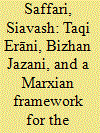

|
|
|
|
|
| Summary/Abstract |
This article examines the development of a Marxian frame for the critique of religion in twentieth century Iranian political thought by Taqi Erāni and Bizhan Jazani. It argues that, following Marx, Erāni and Jazani understand religion to be a superstructural relic from an earlier stage of human development which will gradually and inevitably withdraw from collective human life as a consequence of the material dialectics of history. It further shows that Erāni and Jazani consider religion to be instrumental in sustaining relations of oppression, and they view with skepticism attempts to reform religion or to use religious faith as an instrument for mass mobilization in revolutionary struggles.
|
|
|
|
|
|
|
|
|
|
|
|
|
|
|
|
|
|
|
|
|